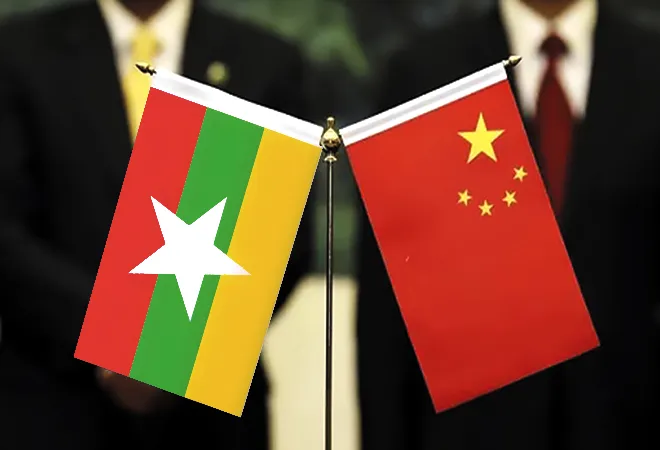
Myanmar has been a strategically important nation for China due to its abundant resources, its geographic position on the eastern coast of the Bay of Bengal, and its land border. Its position facilitates the cost-effective transport of oil over land to Beijing from its ports. Additionally, China is a major trading partner and the second-largest foreign investor that has led several infrastructural projects in the nation, including the ones under the Belt and Road Initiative (BRI). From 1988 to June 2019, the approved Chinese investment amounted to more
than US$25 billion, i.e., nearly 26 percent of the total FDI in the country.
China had been the sole individual nation
investing in Myanmar since 1988 after the western countries sanctioned the latter for its undemocratic and dreadful human rights situation. Once Myanmar transformed into a semi-military regime in 2010, it brought about several positive reforms and liberalised its economy in 2011 thus attracting other foreign investments. This facilitated Myanmar to diversify its partners.
China is a major trading partner and the second-largest foreign investor that has led several infrastructural projects in the nation, including the ones under the Belt and Road Initiative (BRI).
Incidentally, there had been growing public resentment over several China-backed projects that initially led to the
suspension of the Myitsone dam in 2011 and the
resistance over the Letpadaung project. Thus, to subdue the environment, the Chinese authorities underwent changes in their internal policies so as to protect their image and shield their business activities within Myanmar. Beijing subsequently paid more attention to local laws and regulations and increased
corporate social responsibility initiatives and took measures to engage with local population after the democratic government came to power in 2015.
Myanmar subsequently signed the memorandum of understanding on BRI in 2018 and the
China-Myanmar Economic Corridor (CMEC) became a flagship project under the BRI framework. The projects under it aim to connect Kunming, the capital of Yunan, China, to Mandalay and then onwards to Yangon and Kyaukphyu, where a number of projects that were paused were revived and new projects were conceptualised. These include projects such as the Leptadaung Copper mine project (US$
1.065 billion), the railway linking Kunming to Kyaukphyu
(US$8.9 billion), the New Yangon City project
(US$1.5 billion), as well as other economic zones.
Reviving CMEC
The coup in February 2021 initially slowed much of the progress on such projects as Myanmar was marred by political instability, declining human rights situation, and mass destruction due to the civil-military attacks to reinstate the democratic rule.
32 Chinese-backed factories were wrecked as anti-Chinese sentiments grew amongst the masses. This was largely due to the fact that
China shielded Myanmar at the United Nations Security Council (UNSC). Though it was believed that China was being cautious in proceeding with more projects given political turmoil and security concerns, however, the revamping of BRI post-coup shows Beijing’s commitment to do business with the military regime despite losing people’s goodwill.
Myanmar subsequently signed the memorandum of understanding on BRI in 2018 and the China-Myanmar Economic Corridor (CMEC) became a flagship project under the BRI framework.
Post-coup, there has been the
quick implementation of the CMEC projects and a range of cross-border cooperation. The reorganisation of several working committees in the developmental projects that are crucial under CMEC is a signal towards that. It has been observed that China has promised more support for further development in Myanmar and that Beijing has allowed the Myanmar regime
to open a consulate in Chongqing. Moreover, a
650-million RMB grant is also being provided to Myanmar. A
new LNG plant financed by China has been approved by the military regime.
CMEC Projects Underway
| Name of the project |
Total Investment |
Location |
Status |
| Mee Lin Gyaing LNG |
US $2.5 billion |
Ayeyarwady region |
On Going |
| Kyaukphyu Special Economic Zone (KPSEZ) |
US $1.5 billion |
Kyaukphyu Township, Rakhine State |
On Going |
| New Yangon City project |
US $1.5-billion |
Yangon |
Planning |
| Chinshwehaw CBECZ |
– |
Northern Shan State |
Planning |
| Kanpiketi CBECZ |
US $22.4 million |
Northern Kachin State’s Special Region 1 |
On Going |
| Kyaukphyu Power Plant |
US $180 million |
Kyaukphyu Township, Rakhine State |
On Going |
| Kyaukphyu deep sea port |
US $1.3 billion |
Kyaukpyu Township |
On Going |
| Muse – Mandalay Railway |
US $ 8.9 billion |
Mandalay |
Ongoing |
| Mandalay-Tigyaing-Muse Expressway |
|
|
Planning |
| Kyaukphyu-Naypyidaw Highway projects |
|
|
Planning |
Source: Authors Own
Two projects that have been gaining momentum are the Kyaukphyu Deep-Sea Port and Muse-Mandalay Railway, both previously opposed by the local population.
China debt scare
For more than a decade, China has been providing loan support for infrastructural projects in Africa, and South and South East Asia. The
concerning loan issued in Laos and Sri Lanka have added to reservations about Chinese debt. Incidentally, the spokesperson of the Chinese Foreign Ministry, in 2022 stated that Beijing has
outperformed other G20 member nations in Debt Service Suspension Initiatives (DSSI) that were initiated in May 2020. They further added that China will proactively support the developing nations in addressing loan repayment through a
proper burden-sharing process.
While the rearrangements include withdrawing debt and altering repayment conditions, however, this restructuring as has been claimed by international financial institutions is not appropriately transparent. This has created limitations at assessing the level of assistance required by other creditors to support the nation to optimise the external debt position. It is important to point out that
China has not joined the Paris Club, which helps nations pay off loans, because membership would require more transparency.
The Myanmar government has also tried to engage with other neighbours for instance India, Singapore, and Japan and West to balance the Chinese footprints.
According to
Johns Hopkins School of Advanced International Studies’ China Africa Research Initiative, Chinese creditors such as the Exim bank and the China International Development Cooperation Agency have deferred more than US$1.3 billion in debt service in 23 countries under the G20 programme. But it is problematic to identify how much debt has been exonerated by China since the terms and conditions in the initial agreements with the developing countries have not been divulged.
Myanmar Junta is not new to Chinese transparency issues, unsustainable projects, and debt scares. During previous instances, the government has either
negotiated the terms of the agreement, for instance the Kyaukphyu port, or has suspended the projects. The Myanmar government has also tried to engage with other neighbours for instance India, Singapore, and Japan and West to balance the Chinese footprints.
However, the current backlash from western nations and its ASEAN allies has pushed it to make a tactical change. What is now being witnessed is the growing reliance on China. While the Myanmar government is proceeding with the projects in an attempt to resuscitate the economy, it will be doing so without adequately weighing the risks. With Xi acting as the “president for life”, a reliant, controlled, and debt-ridden Myanmar will not be an appropriate future for the military regime in Myanmar. Thus, incorporating democratic changes might put the nation at a suitable juncture to negotiate Whether the Junta will choose to do so or continue to be completely reliant on China will be an important choice it will ultimately need to make.
The views expressed above belong to the author(s). ORF research and analyses now available on Telegram! Click here to access our curated content — blogs, longforms and interviews.



 Myanmar has been a strategically important nation for China due to its abundant resources, its geographic position on the eastern coast of the Bay of Bengal, and its land border. Its position facilitates the cost-effective transport of oil over land to Beijing from its ports. Additionally, China is a major trading partner and the second-largest foreign investor that has led several infrastructural projects in the nation, including the ones under the Belt and Road Initiative (BRI). From 1988 to June 2019, the approved Chinese investment amounted to more
Myanmar has been a strategically important nation for China due to its abundant resources, its geographic position on the eastern coast of the Bay of Bengal, and its land border. Its position facilitates the cost-effective transport of oil over land to Beijing from its ports. Additionally, China is a major trading partner and the second-largest foreign investor that has led several infrastructural projects in the nation, including the ones under the Belt and Road Initiative (BRI). From 1988 to June 2019, the approved Chinese investment amounted to more  PREV
PREV


